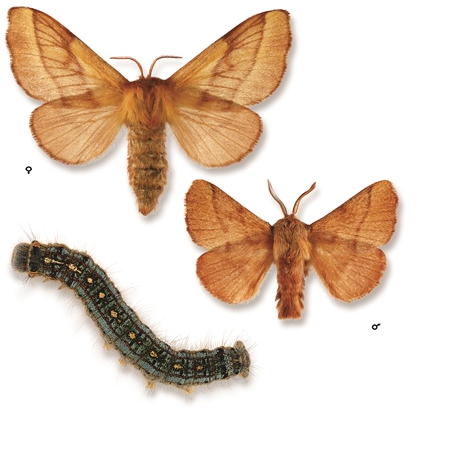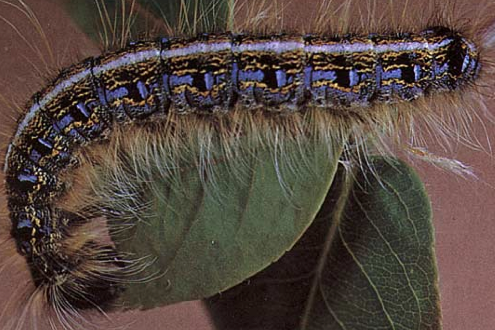Forest Tent Caterpillar Facts

The forest tent caterpillar (FTC) is a native insect that feeds on the leaves of various hardwood trees including aspen, birch, basswood and oak.
Massive Infestations
Despite the devastation to cottage trees, and seemingly plague proportions of the caterpillars, the outbreak is a natural part of the forest ecosystem. Forest tent caterpillars arrive in large numbers on a predictable cycle, with the average wave lasting three or four seasons, culminating in a staggering infestation.
Forest tent caterpillar identification
It is important to avoid confusing FTC with a similar caterpillar, the eastern tent caterpillar (ETC).
The FTC name is a bit misleading because forest tent caterpillars don’t actually produce tents or construct large webbed nests. They simply march by the hundreds or thousands across roads and over buildings in search of trees with fresh leaves.
Distinguishing between the two caterpillars is possible, though they do resemble each other quite closely.
Both caterpillars are about the same size, with black hairs and blue stripes down the side.
FTC has white “key hole” or “footprint” spots down the centre of the back, whereas ETC has a solid white line.

Forest tent caterpillar and moth – source: Natural Resources Canada
ETC is actually the one that spins the ugly tent. While it causes significant damage, the eastern tent caterpillar does not devastate entire forest regions in massive outbreaks.

Eastern Tent Caterpillar – source: Ontario MNR
ETC tents are normally seen in the crotches of branches and are often identified on roadside trees during the summer. The larvae commonly target apple and cherry trees.
To complicate things, populations of FTC will sometimes overwhelm and occupy the tents made by ETC.
FTC lifecycle
Young larvae emerge from the egg mass at about the same time the buds break out on the host trees. Depending on the year this could be as early as mid April or as late as the last week in May.
The caterpillars initially remain in clusters to feed on the leaves of the host tree but will begin to wander in search of more food once the first tree has been defoliated. The larvae go through five growth stages – each lasting seven to ten days.
Depending on the season, this phase can continue through mid June.
The caterpillar then chooses a stable object with a solid anchor point and surrounds itself in a cocoon.
Seven to 10 days later the moth will emerge. This usually occurs in early July.
After mating, the female moths will lay several clusters of eggs on the twigs of host trees. Each cluster contains 150 to 200 eggs that are covered with a sticky substance called spumaline which attaches the cluster to the twig and helps protect the eggs until the following spring.
Check out the Minnesota DNR page on FTC.
What, if anything, can a cottage owner or homeowner do?
Fortunately, the forest tent caterpillar infestation only lasts a few weeks in the early part of the summer. Because FTC is a native species, the affected trees normally recover. In years when the infestation is combined with drought or attacks by other insects, weak trees might not survive.
In the last outbreak, consecutive attacks by FTC on a large forest region in northeastern Ontario resulted in extensive aspen tree mortality.
The MNR says landowners should allow their trees a chance to recover, and not cut trees just because they’ve been defoliated by the caterpillars.
Cottagers can use a high-pressure water spray to remove the caterpillars from individual trees. To prevent the caterpillars from accessing the upper foliage, a ring of paper or tape can be placed around the trunk of the tree and then coated with a sticky substance called “Tanglefoot”.
Disclosure: This post contains affiliate links to products. Cottage Tips may receive a commission for purchases made through these links.
Clippers can be used to remove the egg bands from the twigs of small trees. This can be done in the fall after the leaves have dropped or in early spring before the eggs hatch.
Woodlot owners can hire private companies to spray trees in circumstances where commercial forests are at risk of extensive tree mortality.
Both the Ontario MNR and the Minnesota DNR suggest using Btk (Bacillus thuringiensis var. kurstaki), a biological insecticide created using a bacterium. The product attacks the forest tent caterpillar larvae while they are active and is harmless to beneficial insects.
The insecticide is most effective when the larvae are small. This would normally be in May. As the larvae get larger, they are harder to kill and may defoliate the tree before the pesticide takes its effect.
The spraying should only be done in areas where people are unlikely to be in contact with the insecticide.
Natural control of FTC
Nature also has its ways of controlling the caterpillars. Birds, rodents, bears and other insects take advantage of the bountiful larvae.
A forest tent caterpillar outbreak is usually accompanied by an increase in the population of a parasitic fly called sarcophaga aldrichi.
More commonly known as the “friendly fly”, due to its penchant for landing on people, this insect is one of nature’s key tools for controlling the forest tent caterpillar population.
According to the Minnesota Department of Natural Resources, a massive increase in friendly flies signals the end of the FTC outbreak.
The friendly flies deposit maggots on the FTC cocoons. The maggots burrow into the cocoons and feed on the pupae, preventing them from developing into moths.
Friendly flies resemble the common housefly and often prove to be more bothersome than the caterpillars. The flies descend upon cottagers in irritating swarms, often landing several at a time on a person’s arms and legs. Unlike the skittish housefly, the friendly fly tends to hang on until physically brushed off.
As gruesome as the maggots may sound, another FTC predator, the stinkbug, devastates the colony at the larva stage in a way that resembles something out of a sci-fi horror film.
Read the story and see the amazing photos of our editor’s own encounter with stinkbugs as they slaughtered forest tent caterpillars beside his cottage.





